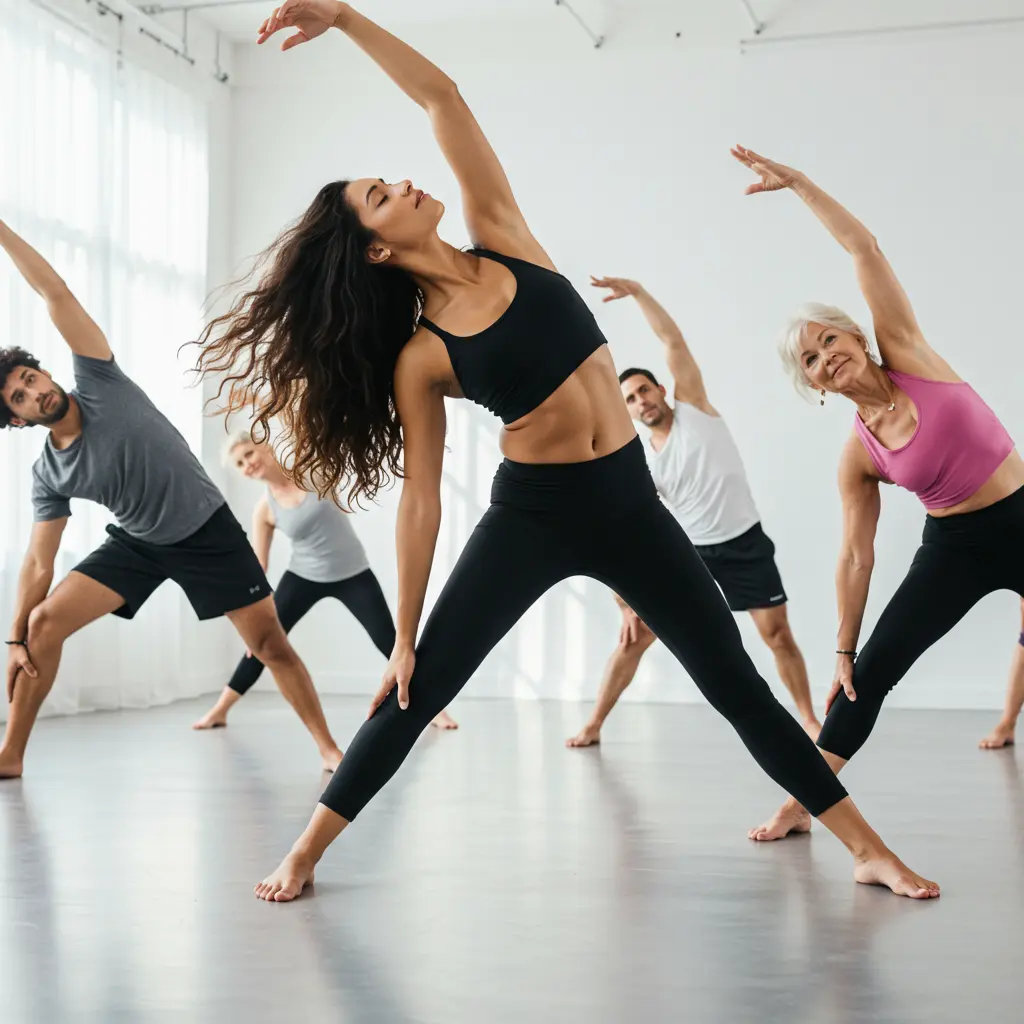Introduction
Flexibility is a key part of staying fit, and it makes daily life so much easier. It’s all about how easily your muscles and joints can move, minus any pesky resistance or discomfort.
Good flexibility can boost your quality of life significantly. It lets you breeze through daily activities and jump into physical endeavors without a hitch.
Flexibility benefits don’t just serve athletes and fitness buffs—they’re for everyone, no matter your age or fitness level. Adding flexibility exercises to your routine boosts balance and helps you stay upright and injury-free. When your muscles and joints are flexible, they’re better prepared for daily tasks and sudden movements, reducing the chance of strains and sprains.
Keep in mind, getting more flexible takes time and regular effort! It’s not something that happens overnight or by doing it randomly.
To develop better flexibility:
- Do regular stretching exercises a few times each week
- Gradually up the duration and intensity
- Make flexibility exercises a staple in your fitness routine
Stick with it, and you’ll start noticing improvements in your movement, balance, and overall well-being.
The Benefits of Stretching
Stretching plays a crucial role in any fitness journey, offering wonderful benefits for both body and mind. One of the most significant perks is the reduced risk of injury.
By improving muscle length and joint range of motion, stretching helps gear up the body for physical activity. This lessens the chance of strains, sprains, and other common injuries – a must-know insight for every athlete and fitness enthusiast.
Want better blood flow? Stretching’s got you covered! Increased circulation rejuvenates your tissues by delivering essential nutrients and oxygen, aiding muscle recovery post-exercise.
This improved blood flow can lead to:
- Reduced muscle soreness
- Less stiffness
- Better consistency in workout routines
- More comfortable exercise sessions
Feeling stressed? Stretching is your trusty tool for relief. In today’s fast-paced world, muscle tension from sitting too long and poor posture is all too common. Regular stretching eases this tightness, promoting relaxation and overall well-being.
Stretching can also become a mindful practice, inviting you to connect with your breath and body sensations. This helps reduce mental stress and anxiety.
In the end, stretching boosts the balance and coordination needed for your everyday activities and workout sessions. Particularly crucial for older adults, better balance means a decreased risk of falls.
Enhanced performance in sports and other physical activities follows improved coordination, letting you pursue fitness goals with ease and confidence.
Static vs. Dynamic Stretching
Stretching is super important and comes in two flavors: static and dynamic. Each one adds value to your fitness journey in its own unique way.
Static stretching involves holding a position for 15-30 seconds to lengthen the muscle and boost flexibility. It’s best performed after a workout when your muscles are all warmed up and ready. Holding these stretches helps your muscle fibers relax and gradually extend their range of motion.
Dynamic stretching is all about moving through a range, often mimicking the moves you’ll do in your workout or sport. It’s typically part of your pre-workout routine to get you all set.
Dynamic stretches are great because they:
- Increase blood flow
- Bump up your body temperature
- Get muscles and joints prepped for action
- Enhance coordination and balance
- Gradually hike up your heart rate
Common dynamic stretches to try include:
- Leg swings
- Arm circles
- Walking lunges
Post-workout static stretching is encouraged because it reduces muscle tension and promotes relaxation. Your toasty muscles are more receptive to stretching now, allowing for a wider range and minimizing injury risks. Plus, it helps ease muscle soreness and speeds up recovery.
When doing dynamic stretches, move with control. Skip the bouncing or jerking to keep injuries at bay.
Static Stretching
Static stretching means holding a pose at the edge of your range of motion for about 20-30 seconds.
This style of stretching works best right after your exercise session when your muscles are already warmed up like a cozy winter sweater.
Studies have shown that doing static stretches can increase your flexibility and help you move more easily.
Dynamic Stretching
Dynamic stretching kicks off your workout with controlled, repetitive motions to get your muscles ready for action.
Use these movements to effectively warm up your body before diving into exercise. With dynamic stretches, you can boost your mobility and enhance your performance for workouts or sports.
How Often and How Long Should You Stretch?
Keeping those muscles limber is key! Dedicate 20–30 minutes to stretching a few times each week to stay flexible and ward off stiffness.
For those static stretches, remember to hold each position for at least 30 seconds. Once you’re feeling more bendy, aim for 1–2 minutes per stretch.
Unleash Your Flexibility with These 5 Workouts
Flexibility isn’t just a bonus—it’s key to your fitness journey and feeling your best self. Adding specific workouts to your routine can make you as limber as a yoga mat, lowering the chance of injury and boosting your prowess in many activities
Mix and match these workouts into your schedule to create a routine that works for you. Remember, start slow and tune into what your body is telling you—it’s all part of the journey.
Stick with it, and you’ll soon see the magic in your range of motion, balance, and overall performance glow up. Just keep amping up the intensity and time spent as you become more flexible.
Yoga
Yoga is an amazing way to boost your flexibility. Famous moves like Downward Dog and Seated Forward Fold stretch your back, hamstrings, and calves beautifully.
Feeling more flexible is just the beginning! Research highlights that doing yoga regularly can improve flexibility by 35% in eight short weeks. Plus, you get the bonus of mindful breathing and stress relief.
Pilates
Pilates is a fantastic workout that zeroes in on core-strengthening exercises, boosting your overall stability and flexibility.
It cleverly targets those smaller muscle groups that other workouts might miss. This focused method is a surefire way to improve mobility and slash your injury risk.
Tai Chi
Tai chi’s gentle, flowing movements are perfect for boosting your balance and joint mobility.
This age-old practice mixes mental focus with smooth, effortless transitions between poses.
Studies reveal tai chi’s ability to enhance balance performance and lower the risk of falls particularly for older adults.
Foam Rolling
Get ready to roll with foam rolling—your go-to for easing those tight muscles and keeping them happy.
It’s a simple yet effective way to boost circulation and flexibility. When you make foam rolling part of your pre- or post-workout routine, you’re setting the stage for better recovery and top-notch performance.
Foam rolling come with a bundle of benefits:
- Helps loosen tight muscles
- Boosts circulation and recovery
- Elevates range of motion
Get Moving with Dynamic Warm-Up Drills
Getting your body in motion with dynamic warm-up drills is an essential step to kickstart any workout session.
Try incorporating these:
- Leg swings
- Butt kicks
- Frankenstein walks
These moves prime your body for more intense exercise and help ward off injuries.
For best results, dive into these dynamic stretches post-light cardio as a part of your full warm-up routine.
Essential Tips for Safe Stretching
Get into the groove with a proper warm-up before starting any stretching routine. It’s key to avoiding injuries and boosting your flexibility.
Try some light aerobic activity like a brisk walk or a bit of jogging on the spot for 5-10 minutes. This gets your blood pumping, making your muscles more stretchy and ready to roll.
Here are some must-know tips when you’re stretching:
- Avoid bouncing or jerking movements to prevent pesky micro-tears in your muscles
- Hold each stretch steadily for 15-30 seconds
- Stretch to the point of mild discomfort, not pain
- Sharp pain is a no-go—stop right away and check your form
Remember, breathing properly is essential during your stretching. Don’t hold your breath; it can create tension and reduce the stretch’s impact.
Keep your form on point by concentrating on the muscle you’re working on, while the rest of your body stays chill.
Consider using a mirror to ensure you’re aligned or even consult a fitness pro for technique tips. Follow these handy guidelines to safely amp up your flexibility, range of motion, and overall wellness.
Stay Flexible and Shine
Simple stretch breaks can be your secret weapon to enhance flexibility and wave goodbye to stiffness. Sneak in a few stretches every couple of hours, targeting those pesky tight spots.
This habitual practice transforms flexibility from a task to a lifestyle, opening the door to smoother, more fluid movements in your everyday adventures.
Need a helping hand with your stretching game? The Daily Burn app has you covered with dynamic yoga and flexibility routines. Dive into our expansive collection of workout videos that let you enhance your flexibility at a rhythm that suits your life.
Remember, consistency and patience are your best friends on this journey to becoming more flexible. Keep going even if progress seems slow; change happens over time, and your body is aligning itself just right.
Stay on track with these tips:
- Tune into how your body feels
- Stick with a stretch schedule
- Celebrate your small wins
- Give yourself grace as you grow
Want more fitness inspiration? Check out dailyburn.com. Discover incredible resources and motivation to power up your health journey. Whether it’s boosting your flexibility, gaining strength, or enriching your wellness, Daily Burn is your partner all the way.


